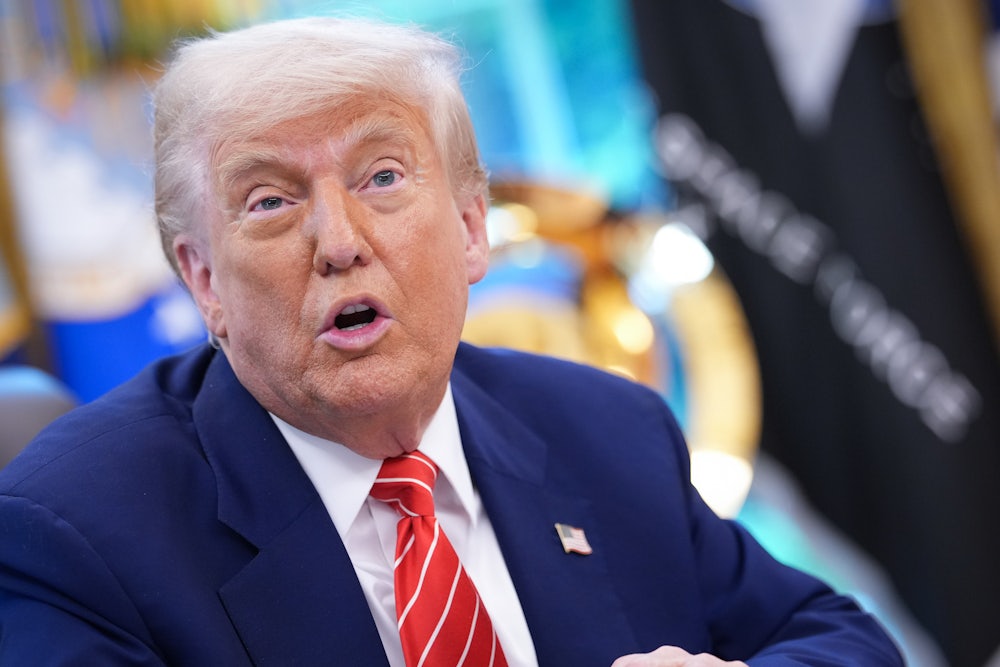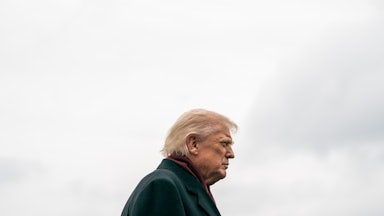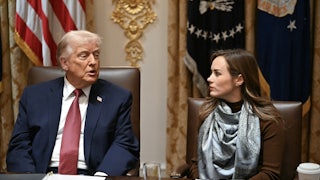When Richard III seized the English throne toward the end of the Wars of the Roses, he pressured Parliament to legitimize his usurpation of the Crown from his nephews. Parliament responded by passing a law that accused the late Edward IV, Richard’s brother, and Edward’s wife, Elizabeth Woodville, of all manner of misdeeds. The law, Titulus Regius, was an incendiary one.
It claimed that Edward’s reign had seen the laws of God and his Church, of nature, and of England left “broken, subverted and disregarded, contrary to all reason and justice.” It denounced his marriage as invalid, in part because Elizabeth had allegedly bewitched him through “sorcery and witchcraft.” And it conveniently declared that their children, who stood ahead of Richard in the line of succession (and had gone missing under his care), were bastards and automatically ineligible for the throne.
The United States is a republic, not a monarchy. But that has not stopped President Donald Trump from taking a similar approach to declaring his predecessor’s administration invalid. This week, he issued a memorandum to direct Attorney General Pam Bondi to investigate whether Biden’s White House advisers had used an autopen device to fabricate Biden’s signature on official documents.
Though the memo did not go so far as to accuse Biden officials of using sorcery to bewitch him, it argued that they took advantage of his allegedly compromised mental state to wield presidential powers. “This conspiracy marks one of the most dangerous and concerning scandals in American history,” it said. “The American public was purposefully shielded from discovering who wielded the executive power, all while Biden’s signature was deployed across thousands of documents to effect radical policy shifts.”
Trump had already signaled that his focus was on Biden’s pardons of various people whom he sees as political enemies. “The ‘Pardons’ that Sleepy Joe Biden gave to the Unselect Committee of Political Thugs, and many others, are hereby declared VOID, VACANT, AND OF NO FURTHER FORCE OR EFFECT, because of the fact that they were done by Autopen,” he wrote in a post on his personal social media website in March. “In other words, Joe Biden did not sign them but, more importantly, he did not know anything about them!”
Conservative media outlets have written extensively about the previous administration’s use of an autopen in recent months, insinuating that it was a sign of Biden’s incapacity. There is no evidence that it was used to sign things against the former president’s will. Focusing on it is a throwback of sorts to the Obama years, when Obama began to use the device while traveling overseas. He first used the autopen to sign an extension of the PATRIOT Act in 2011, during a weeklong tour of Europe. In 2013, he used it while vacationing in Hawaii to sign the bill that prevented the U.S. government from going over the so-called “fiscal cliff.” Less notable uses also followed, such as signing routine annual proclamations.
Obama’s autopen use initially raised some constitutional questions since Article 1 requires the president to “sign” legislation before it can become law. Conservatives occasionally brought it up as part of their broader efforts to paint Obama’s tenure as illegitimate in various ways. But a 2005 opinion by the Justice Department’s Office of Legal Counsel found no issue with a president directing his signature to be attached to a document as opposed to signing it by his own hand. It grounded its reasoning in ancient principles of English and early American legal tradition.
“Under the ‘principle of signatures,’ the common law recognized that one could sign a document not only with one’s own hand, but also by the hand of another who was properly authorized to affix one’s signature to the document on one’s behalf or who did so in one’s presence,” the office explained. “Furthermore, a document signed in one’s name by the hand of another in either of these manners was equally effective as a document signed with one’s own hand.”
It is worth noting that the original autopen controversy stemmed largely around the president’s use of it to sign legislation, where the Constitution explicitly requires a signature. For practical reasons, presidents do not commit all or even most of their orders, instructions, or official actions to paper. A president’s direct order to someone serving in the military, for example, carries the same legal weight whether delivered over the telephone, via videoconference, or in person.
Since Trump’s particular issue with the autopen centers around pardons, it’s worth noting that the historical precedents for that power are much looser than for any other official act a president might undertake. The modern practice is for would-be recipients to apply to the Justice Department’s Office of the Pardon Attorney, which reviews cases and makes recommendations to the president. If the application is approved, the office gives pardon recipients a formal document bearing the president’s seal and signature.
That is a modern convenience rather than an actual legal requirement, however. Trump himself has ignored or bypassed the pardon attorney and issued almost all of his pardons at his personal whim. Past presidents have also wielded the pardon power by proclamation instead of individualized certificates. They have issued mass pardons to ex-Confederate officials, to formerly polygamous Mormons, Vietnam War draft evaders, and so on without difficulty.
My favorite examples of the pardon power’s ad hoc usage come from the Civil War. Abraham Lincoln developed a reputation during his time in office as a bit of a soft touch when it came to clemency. He was also strikingly informal about it. In one encounter, Lincoln wrote out a pardon for a young boy accused of desertion on a nearby scrap of bandage. When General Joseph Hooker once sent a list of death warrants for 55 convicted deserters to the White House during the war, historian Ron Soodalter recounted, Lincoln simply wrote “pardoned” on the envelope and mailed it back.
Lincoln’s current successor is familiar with this freewheeling approach to governance, albeit to achieve far different ends. Trump has often gone to great lengths to conceal or destroy government records, whether by tearing them up after he is done with them or absconding with them to his Florida golf resort. He notoriously does not use email or a computer and prefers to conduct business over the phone instead of putting anything into writing. This approach conveniently avoids creating a paper trail that could be used against him later.
Trump has also argued before that a president’s intent matters more than the precise physical or ministerial act that he performs when running the executive branch. He asserted in a 2022 interview with Fox News host Sean Hannity, for example, that he could declassify documents telepathically. “There doesn’t have to be a process, as I understand it,” Trump said. “You’re the president of the United States; you can declassify just by saying it’s declassified, even by thinking about it.”
Naturally, part of Trump’s argument is that Biden’s intent was dubious because of his “cognitive decline” while president. “This was especially true of actions taken during the second half of his Presidency, when his cognitive decline had apparently become even more clear to those working most closely with him,” his memorandum stated. The “investigation” appears designed to create a pretextual justification to nullify a wide range of official actions undertaken by the Biden administration. The White House’s documents take pains to mention Biden’s executive orders and judicial appointments as part of this alleged scheme.
“If his advisors secretly used the mechanical signature pen to conceal this incapacity, while taking radical executive actions all in his name,” the memorandum claimed, “that would constitute an unconstitutional wielding of the power of the Presidency, a circumstance that would have implications for the legality and validity of numerous executive actions undertaken in Biden’s name.”
If someone forged Biden’s signature on an official document that carried legal weight, that would indeed be a scandal and could be a criminal offense. But Trump’s theory has a few flaws in it. For one thing, there is no evidence that any Biden officials took any actions without his approval or consent. Biden himself has also denied that it happened. “I made the decisions about the pardons, executive orders, legislation, and proclamations,” he said in a statement on Friday. “Any suggestion that I didn’t is ridiculous and false.”
Trump’s idea that a president could invalidate all of his predecessor’s acts by claiming that predecessor was mentally incompetent at the time is also untenable, both practically or legally. There is no “undo” button in the Constitution. A Democratic president could also do the same thing to the Trump administration’s executive actions and judicial appointments upon taking office in 2029, perhaps even extending it to his first term. After all, Trump’s own mental fitness is far from uncontested: He publicly defended himself from such claims in 2018 by boasting that he was a “very stable genius.”
For those reasons, Trump’s own attempt to delegitimize his predecessor’s administration would be unlikely to achieve any substantial legal goals. A Supreme Court where one-third of the justices were appointed by Trump is unlikely to agree that a mentally incompetent president’s judicial appointees can be removed from the bench by executive fiat. As with Richard III’s Titulus Regius, the memorandum’s real effect may be as propaganda—grist for the content mills of right-wing media. That this is all arriving ahead of a summer simmering with bad economic headwinds is significant. Even so, it will be hard to distract from the damage wrought by Trump’s own administration over the next four years.










